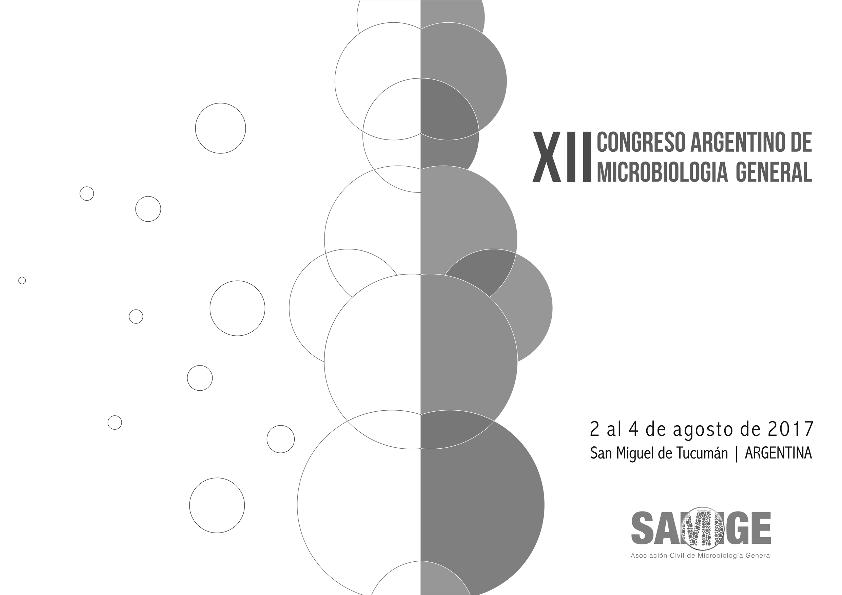Evento
Characterization and properties of a microbial emulsifier produced from crude glycerol
Rulli, Macarena María ; Alvarez, Analia
; Alvarez, Analia ; del Gobbo, Luciana Melisa
; del Gobbo, Luciana Melisa ; Fuentes, María Soledad
; Fuentes, María Soledad ; Colin, Veronica Leticia
; Colin, Veronica Leticia
 ; Alvarez, Analia
; Alvarez, Analia ; del Gobbo, Luciana Melisa
; del Gobbo, Luciana Melisa ; Fuentes, María Soledad
; Fuentes, María Soledad ; Colin, Veronica Leticia
; Colin, Veronica Leticia
Tipo del evento:
Congreso
Nombre del evento:
XII Congreso Argentino de Microbiología General
Fecha del evento:
02/08/2017
Institución Organizadora:
Asociación Civil de Microbiología General;
Título del Libro:
XII Congreso Argentino de Microbiología General
Editorial:
Asociación Civil de Microbiología General
Idioma:
Inglés
Clasificación temática:
Resumen
Bioemulsifiers (BE) are amphipathic molecules used in the bioremediation field due to the role in emulsification, solubilization, and removal of hydrophobic compounds from the environment. The ability of a spore-forming bacterium to produced BE using crude glycerol as a cheap feedstock was previously detected. In the current study, partially purified BE was characterized. The ability of the microbial product and of two commercial synthetic agents such as sodium dodecyl sulfate (SDS) and Triton X-100 (TX-100) to emulsify hydrophobic substrates was also comparatively evaluated.Culture supernatant containing BE was filtered through a dialysis tubing cellulose membrane (Typical molecular weight cut-off = 14,000 Da). The concentrate obtained was then used as BE source, and subjected to hydrolytic treatments with proteinase K (30 U mg −1 at 37 °C for 4 h), commercial lipasefrom Candida rugosa(100 U mg −1 at 37 °C for 1 h), and acid hydrolysis (10% HCl at 100 °C for 10 min) in order to estimate the role of peptides, lipids and sugars on the BE nature. The biodegradability of BE, SDS and TX-100 was assayed using the BOD/COD ratio, with BOD and COD as the biological and chemical oxygen demand, respectively. BOD and COD parameters were determined according to the Standard Methods for the Examination of Water and Wastewater. Finally, it was evaluated the emulsifying ability of the three agents on hydrophobic substrates (kerosene, toluene, chloroform, chlordane pesticide and vegetable oils), determining the emulsification index for each substrate after being left to settle for 24 h (E 24). All hydrolytic treatments significantly reduced the BE activity on the kerosene, suggesting that microbial product could have a protein fraction as well as sugar and lipid fractions. On the other hand, a virtually negligible BOD/COD ratio was detected for SDS and TX-100 (0.070−0.172), confirming the extremely low biodegradability of these synthetic products. However, BOD/COD ratio was significantly increased for BE (0.386) confirming so its biodegradable character. Finally, a differential performance of the BE, SDS, and TX-100 to emulsify the hydrophobic compounds was detected: a similar performance of the three agents to emulsify substrates as kerosene and toluene were detected, with E 24 -values of 61% and 62%, respectively. However, chloroform was only effectively emulsified by the BE, with an E 24 -value increased 4-fold compared to those detected for the synthetic agents. While SDS had poor ability to emulsify a pesticide such as chlordane (E24 = 18%), the BE and TX-100 wereoptimal emulsifying agents for this substrate, with similar E 24 -values between them (61%). Finally, only the BE was able to emulsify vegetable oils as sunflower, canola, and grape, with E24 -values that ranged from 38% to 51%. These results could encourage the application of a biodegradable microbialproduct to achieve the effective removal of hydrophobic pollutants, without detriment to the environment.
Archivos asociados
Licencia
Identificadores
Colecciones
Eventos(PROIMI)
Eventos de PLANTA PILOTO DE PROC.IND.MICROBIOLOGICOS (I)
Eventos de PLANTA PILOTO DE PROC.IND.MICROBIOLOGICOS (I)
Citación
Characterization and properties of a microbial emulsifier produced from crude glycerol; XII Congreso Argentino de Microbiología General; San Miguel de Tucuman; Argentina; 2017; 1-2
Compartir



